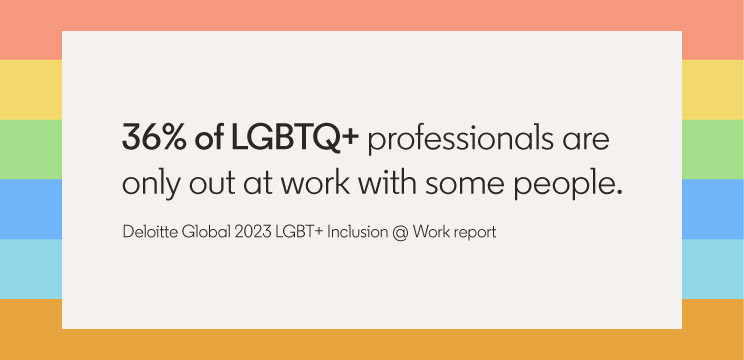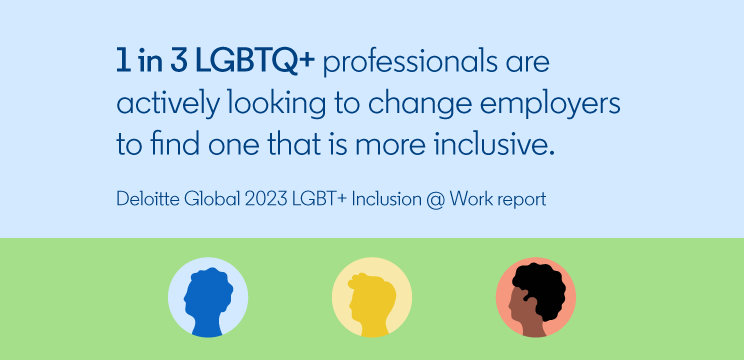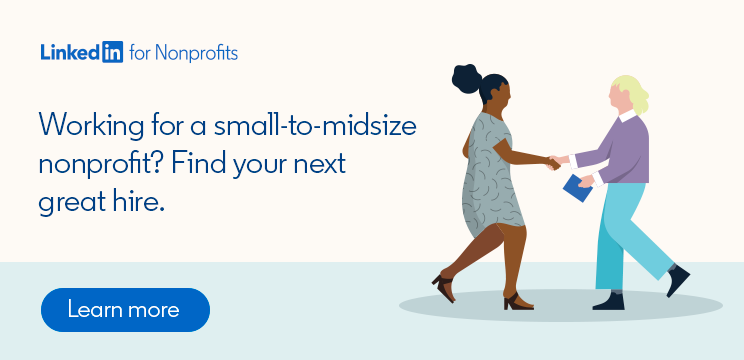
5 Everyday Actions Your Nonprofit Team Can Take to Foster LGBTQ+ Inclusion
Building a diverse team can better equip nonprofits to understand the varied needs of the communities they serve. But diversity alone is not enough. By fostering a culture of inclusion and belonging, organizations can empower all team members to bring their unique perspectives and voices to the table.
For LGBTQ+ professionals, this kind of culture can sometimes be hard to find. The Deloitte Global 2023 LGBT+ Inclusion @ Work report found that, across the various sectors and countries surveyed, 42% of LGBTQ+ employees report having experienced non-inclusive behaviors at work — and one-third are actively looking to move to a more LGBTQ+ inclusive employer.
Nonprofits can nurture inclusivity through actions like creating employee resource groups (ERGs), clearly communicating anti-discrimination policies, and exploring ways to make workforce benefits more inclusive of LGBTQ+ employees and their families. But you might be wondering what you, as a manager or employee, can do to help ensure all team members feel like they belong.
Everyone can contribute to creating and maintaining a culture of inclusivity and belonging — and everyday actions matter. Here are five that can help.
5 ways to help create a more LGBTQ+ inclusive culture at your nonprofit
Action #1: Check your assumptions
While it’s common to make assumptions based on our own lived experiences or what we perceive as societal norms, it’s important to remember that these may not reflect the lives of our colleagues.
When you catch yourself making an assumption, try to step back and evaluate the belief before voicing it. Ask yourself, is there a different word you could use to avoid assuming a person’s gender identity or sexual orientation? For example:
Use the word “partner” instead of husband or wife if you are unfamiliar with a coworker’s spouse.
Swap out terms like “ladies and gentlemen” for “folks” or “everyone” when speaking to a group.
Refer to a coworker by their name, rather than using a pronoun, if you’re unsure how they identify. When in doubt, it’s always better to ask than assume.
Check out Pronouns.org for more guidance about how to use gender-inclusive language at work.
Action #2: Practice discretion
The Deloitte Global 2023 LGBT+ Inclusion @ Work report found that, globally, fewer than half of the LGBTQ+ professionals surveyed are fully out at work about their sexual orientation (43%) or gender identity (47%). Another 36% say they are only out about their sexuality or gender with some colleagues.
If a coworker comes out to you (intentionally or by accident), be aware that they may not be out to everyone. Don’t share the information with others or pressure the coworker to do so.

"Let the employee themselves determine who, when, and how they want to communicate [that information] to any other member of the team — and that's if they want to,” says George Evans, trans activist and LinkedIn Top Voice, in a LinkedIn video. “They don't have to. It's entirely up to them."
Not sure how to respond if a coworker comes out to you? Consider saying: “Thank you for sharing that with me. How can I best support you?”
Action #3: Be curious, but not intrusive
If an LGBTQ+ coworker feels comfortable discussing their lived experiences with you, this can provide a valuable opportunity to get to know them better and learn about identities other than your own. But be sure to let your coworker initiate and lead the conversation. Practice active listening and follow their cues, allowing them to dictate how much they share and when.
If you have follow-up questions for your coworker, here are some things to keep in mind before you ask:
It’s okay to want to learn more about a person and their experiences, but it’s also okay for your coworker to decline to answer. Respect their boundaries.
Avoid any questions that are overly personal or invasive. As a rule of thumb, if it’s not something you would ask a non-LGBTQ+ coworker, it could be stigmatizing.
Where possible, try to find the answer yourself before going to your coworker. There are many books, podcasts, and online resources that you can check out to educate yourself about different LGBTQ+ identities and experiences.
Action #4: Aim to be an upstander, not a bystander
One of the best ways to build an inclusive culture at your nonprofit is to practice inclusive behavior even when the people who would be personally affected by non-inclusive behavior are not in the room. If you hear someone making a biased or otherwise inappropriate comment about an LGBTQ+ coworker who isn’t present, don’t let it pass unchallenged.
Weigh up the circumstances and intent when determining the appropriate response. For instance, if someone misgenders a colleague once, offering a friendly, real-time reminder about their correct pronouns may be the best way to encourage more inclusive language in the future. But if the same person continuously misgenders your coworker or reacts negatively when corrected, it may be time to escalate the issue to HR.

Being an upstander can help take the pressure off LGBTQ+ employees to always be the ones reporting inappropriate behavior, which many fear will negatively impact their day-to-day work life or long-term career opportunities. The Deloitte Global 2023 LGBT+ Inclusion @ Work report noted that, among respondents who didn’t report non-inclusive behavior to their employer, 30% were concerned that reporting the issue would adversely impact their career — and 39% feared that doing so would only make the situation worse. This may explain why many are considering leaving their jobs in search of more inclusive employers.
Action #5: Apologize and learn from mistakes
Nobody is perfect, and part of being a good ally is recognizing that you don’t know everything and may occasionally slip up. If you realize you’ve made a mistake or a coworker flags one to you, remember to ACT:
- A: Acknowledge the mistake and apologize
- C: Correct yourself
- T: Try again
This simple framework can help you to respond effectively and empathetically in the moment, without calling extra attention to the mistake in a way that might embarrass your LGBTQ+ coworker.
An inclusive nonprofit culture can be a major talent advantage
Creating an inclusive nonprofit culture is a reward in itself, but it can also support your organization’s talent goals, helping you attract, hire, and retain the talent you need to make a difference for the communities you serve. When all staff feel welcome and respected in the workplace, they can bring their very best self to work — and make an even bigger impact at your nonprofit.
Learn more about how you can build a diverse and inclusive nonprofit workplace with LinkedIn. Download our guide today.

